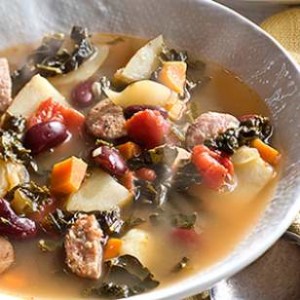Demystifying Food Labels
It is very important to pay attention to food labels, and although changes have been made to make them more user friendly, they can still be confusing. Food labels are one of the most important ways to comparison shop (next to cost) when you are at the market and they give you critical information that impacts your health. Lets start at the top and work our way down.
- Serving size and calories: The serving size tells you how many calories there are PER SERVING. This is important to note, as there may be more than one serving per container. This label is 200 calories for the whole item. If the next line had servings per container, lets say 2 and you ate the whole package, you would have consumed 400 calories. If you ate this whole package, you would have consumed 172 grams of the items as noted by the serving size on the top line. The general rule for calories is:
- 40 calories is low
- 100 calories is moderate
- 400 calories or more is high
- Nutrients: The first nutrients listed on the food label are those that people consume enough of or too much (fat, saturated fat, trans fat, cholesterol and sodium)-these nutrients should be limited. These nutrients can increase your risk of diseases like heart disease, high blood pressure and some cancers. It is important to note that even if a food is labeled trans fat free it may contain small amounts of trans fat. Look for hydrogenated oil in the ingredient list and you will know that that food does contain trans fat. It is also important to note that canned and packaged foods tend to be too high in sodium. You need more of the nutrients that are lower on the label such as fiber, vitamin A, Vitamin C, calcium and iron. This part of the label is a great way to figure out of the product you are considering has nutritional value.
- Daily Values (%DV): Daily values represent recommended levels of intake. % Daily values are based on a 2000 calorie diet and are based on the daily value recommendation for key nutrients. It is very important to pay attention to these numbers. A %DV of 5% or less is low 10-19% is good and a %DV of 20% or more is high. So for those nutrients you want to limit, you want a %DV of 5% or lower and those nutrients you want to increase you want to see a higher %DV. You always want to make sure that you keep your total fat for the day below 100%DV.
- Total Carbohydrate: Total carbohydrate on the label includes all types of carbohydrate – sugar, complex carbohydrate and fiber. Because all types of carbohydrate can affect blood glucose, it’s important to use the total grams or choosing foods to include, rather than just the grams of sugar.
- Sodium: Keep your sodium intake to 2,300 milligrams a day or less. Persons 51 and older, African Americans, or people who have hypertension, diabetes or chronic kidney disease should limit sodium to 1500 milligrams daily.
- Dietary fiber: Fiber helps fill you up, can help lower cholesterol, and keeps you regular. You need at least 25 to 38 grams daily. To be considered high in fiber, a food must contain least 5 grams per serving.
- A note on Calcium: Adults should consume 1,000mg or 100%DV in a day, post-menopausal women should consume 1,200mg daily (remember this relates to a 2000 calorie diet). Always pay attention to calcium in the label as all foods are not created equal. The equivalencies for calcium are: 30% DV=300mg calcium=8 ounces milk, 100% DV=1,000mg calcium and 130% DV=1,300 mg calcium.
- Ingredients-Ingredients are listed by weight from highest to lowest. Therefore, if sugar is the first ingredient listed, it is the most prevalent. Pay attention to sugar intake and look to decrease sugar, corn syrup, high-fructose corn syrup, maltose, dextrose, maple syrup, sucrose, honey, fruit juice concentrates, and brown rice syrup. If you are not sure what an ingredient is, look it up, you may be surprised to learn what it is and what it does to your food and your body. The less ingredients in a list the better off you are and if you can’t pronounce or understand a certain ingredient, maybe you should rethink that food.
You would never buy a high ticket item like a car or expensive electronic without comparison shopping. Your food label is the best way to comparison shop and get the healthiest, best bang for your buck! Never just grab the first item off the shelf in the market. Look at a few items in the same category to make the best decision possible.
Portuguese Kale & Red Bean Soup
From EatingWell: January/February 2015
This vegetable-packed healthy soup recipe is inspired by caldo verde, a Portuguese soup made with kale, potatoes and linguica sausage. We added protein-rich kidney beans, tomatoes and carrots to make it more substantial. If you can’t find linguica, andouille sausage or chorizo makes a delicious substitute.
Makes: 8 servings
Serving Size: about 1 2/3 cups
Active Time: 50 minutes
Total Time: 1 hour
NUTRITION PROFILE
|
INGREDIENTS
• 1 tablespoon extra-virgin olive oil
• 10 ounces linguica or andouille sausage, halved lengthwise and sliced 1/4 inch thick
• 1 cup chopped onion
• 1 cup chopped carrot
• 2 tablespoons finely chopped garlic
• 6 cups low-sodium chicken broth or stock (or see Slow-Cooker Stock recipe, below)
• 1 14-ounce can diced tomatoes
• 1 tablespoon chopped fresh marjoram or thyme
• 1 pound small white boiling potatoes, halved and sliced 1/4 inch thick
• 1 pound kale or other dark leafy greens, stems removed, cut into 1/4-inch strips
• 1 15-ounce can kidney beans, rinsed
• 1/2 cup chopped fresh parsley
• 1/4 teaspoon salt
• Ground pepper to taste
PREPARATION
1. Heat oil in a large pot over medium heat. Add sausage and cook, stirring often, until lightly browned, 4 to 5 minutes. Transfer the sausage to a plate. Add onion and carrot to the pot; cover and cook, stirring occasionally, until soft, 5 to 10 minutes. Stir in garlic and cook 1 minute more. Add broth (or stock), tomatoes with their juice and marjoram (or thyme). Cover and bring to a boil. Add potatoes, reduce heat and simmer, uncovered, for 10 minutes.
2. Stir in the reserved sausage, kale (or other greens), beans and parsley. Return to a simmer and cook, stirring often, until the potatoes are tender, 4 to 5 minutes more. Season with salt and pepper.
TIPS & NOTES
• Make Ahead Tip: Cover and refrigerate for up to 3 days.
• Slow-Cooker Chicken Stock: Cut 1 medium carrot, 1 celery stalk and 1 small onion into 1-inch pieces. Combine with 4 pounds skinless chicken leg quarters, 6 sprigs fresh parsley, 2 sprigs fresh thyme, 1 bay leaf, 1 crushed garlic clove and 20 whole peppercorns in a 6-quart slow cooker. Add 9 cups water. Cook on High for 4 hours. Strain and let cool to room temperature before refrigerating airtight for up to 1 week or freezing for up to 3 months. Makes: about 10 cups.
• After straining, this stock has negligible calories, nutrients and sodium.
NUTRITION
Per serving: 273 calories; 8 g fat (2 g sat, 2 g mono); 35 mg cholesterol; 34 g carbohydrates; 4 g total sugars; 19 g protein; 7 g fiber; 558 mg sodium; 1012 mg potassium.
Nutrition Bonus: Vitamin A (175% daily value), Vitamin C (142% dv), Potassium (29% dv), Iron (18% dv), Folate & Magnesium (17% dv), Calcium (15% dv)





